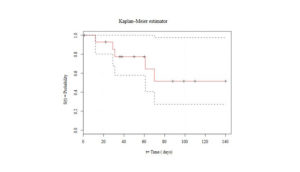As life finally (hopefully!) begins to return to normal, over two years since the beginning of the pandemic, now seems like a good moment to reflect a bit on the science of epidemiology and its influence on our lives. When working with big data or on large scale projects, it can be easy to forget that there are individual lives hidden behind the statistics and survival curves. That certainly changed with the pandemic when instead of just analyzing statistics, we became part of the data (people who had had Covid or not, people who’d been vaccinated, etc.) like everyone else on the planet.

JOHN SNOW’S CHOLERA MAP
Over five years ago, when we started Broadstreet and chose the company’s name, we deliberately sought to link ourselves to a bit of epidemiology lore. Little did we image that name would become so relevant to our present day. In case you’re not aware, the name Broadstreet recalls a seminal event in the history of epidemiology, an event that has become distilled almost to myth—the removal of the handle of the Broad Street pump during the 1850s cholera outbreak in London. English physician John Snow would become one of the founders of modern epidemiology through his shoe-leather-based approach to curb that epidemic. Having created his famous map to track the spread of the disease, he is credited, probably apocryphally, with removing the handle from the water pump which was the source of the cholera and thus single-handedly stopping the epidemic.
The truth is, of course, more complex and nuanced and fascinating in its parallels to our collective lived experience over the last few years. Like the massive collaborative efforts we saw around the world to stem the tide of COVID-19, John Snow wasn’t working alone either. Snow was able to make use of statistics gathered by William Farr, who in his role with the UK’s General Register Office, pioneered the use of medical statistics in epidemiology. Snow’s famous map was actually born out of an earlier map of the epidemic drawn up be Edmund Cooper at the behest of the Metropolitan Commission of Sewers. And the decision to remove the pump handle was made by the city’s board of health (a public health order which, at the time, was met with derision in some quarters).
Like our modern public health officials, John Snow struggled to make headway against stubbornly persistent misinformation and baseless theories. In particular, the theory that disease was spread by miasma, unpleasant odours and vapours, was espoused by some of the leading scientists of the time as well as by the city’s newspapers, the social media of their day. The dominance of this theory made it hard for Snow to convince people that their drinking water was what was killing them. Newspapers were also a source for quacks and con artists to push baseless ideas about how to avoid getting sick and to sell useless “cures” to those who were. Sound familiar?

A MAP OF THE COVID OUTBREAK IN TRINIDAD AND TOBAGO, 1 APRIL 2020
The legacy of Snow’s work (and that of his collaborators) has been front and centre over these past couple of years. Possibly most importantly, it is an early example of science-based decision-making in government. Snow presented his research to the appropriate government body and the decision to close the pump was made based on that research. Much like the massive compiling of data that has been at the core of research into COVID-19, the extensive statistics collected by William Farr were key to Snow’s work, providing the source material for the patterns Snow identified.
His work would be seen as the birth of field epidemiology. He went door to door to really understand where and how the disease was spreading. His use of maps to collect and communicate this information visually were key to swinging opinion in his favour. The endless maps we saw of the spread of our pandemic are a direct descendant of Snow’s map, as are in a wider sense, the wide variety of data visualizations we use today to communicate scientific findings.
We choose to link ourselves with John Snow and his work because the story resonates with us for many reasons. His focus on the importance of looking for patterns and his understanding of the value of the use of visualizations for scientific communication are central to the way we work. But perhaps most of importantly what speaks to us is the collaboration and meticulously detailed work that led to the closing of the Broad Street pump. This, very much, is reflective of our own working philosophy at Broadstreet.

